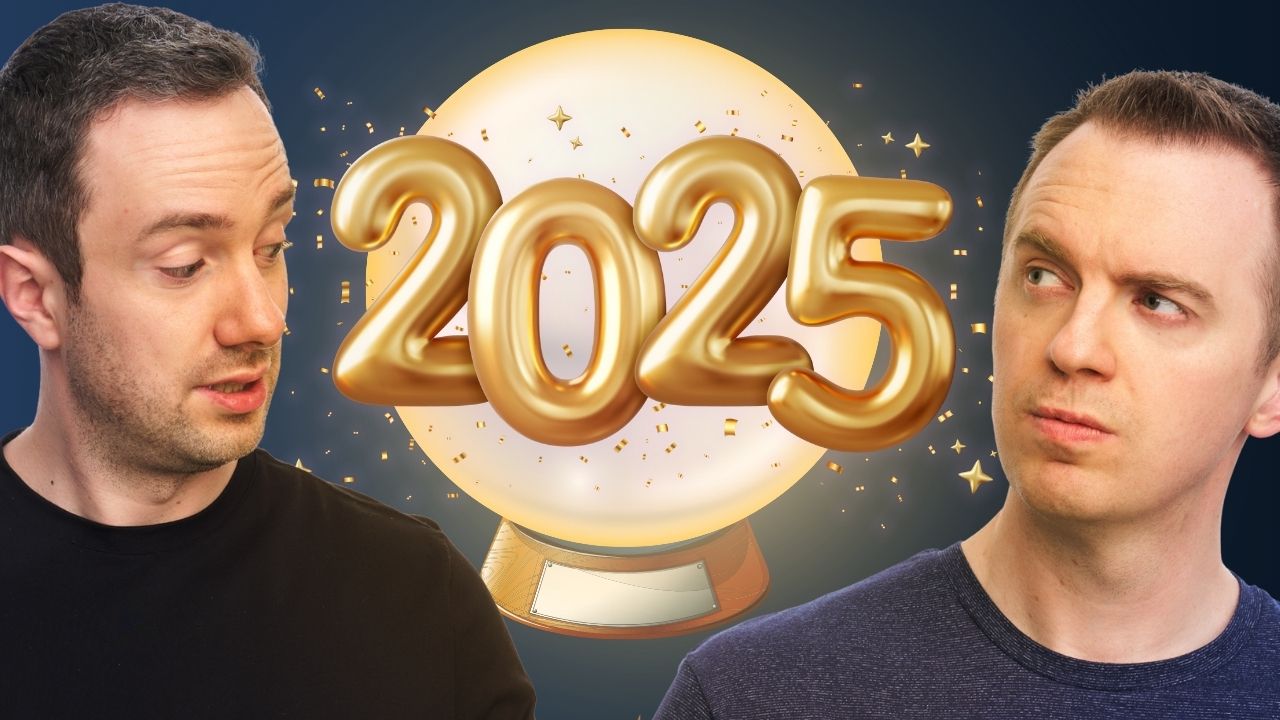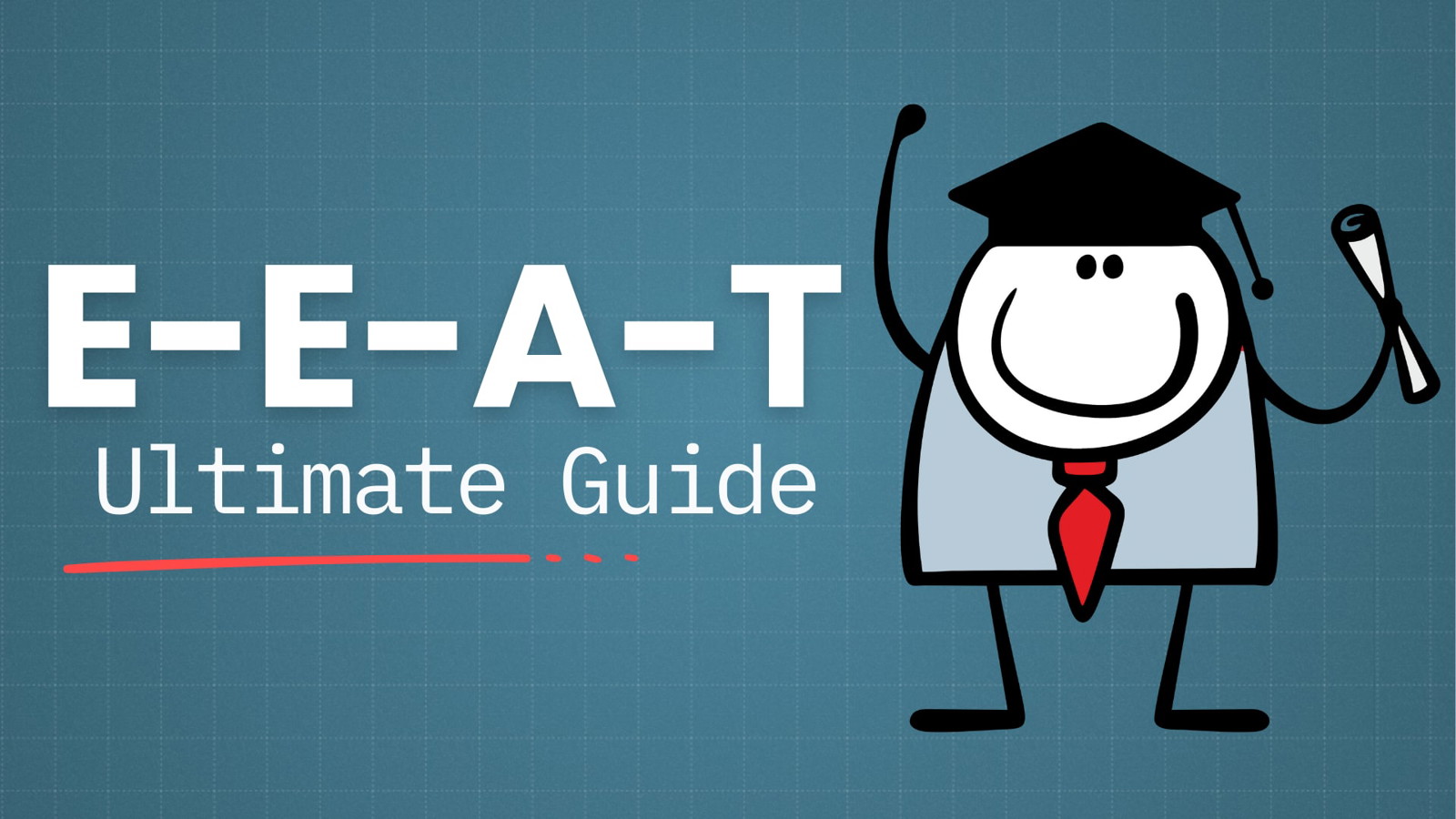Organic traffic rocks and backlinks are what gets it for you.
That’s because a quality backlink profile is the single most important factor when it comes to ranking highly in Google.

But there’s more to backlinks than just the sheer number of them.
Authority of the referring URL matters a lot.
Relevancy matters too.
And finally, there’s the anchor text to every backlink that Google considers important as well.
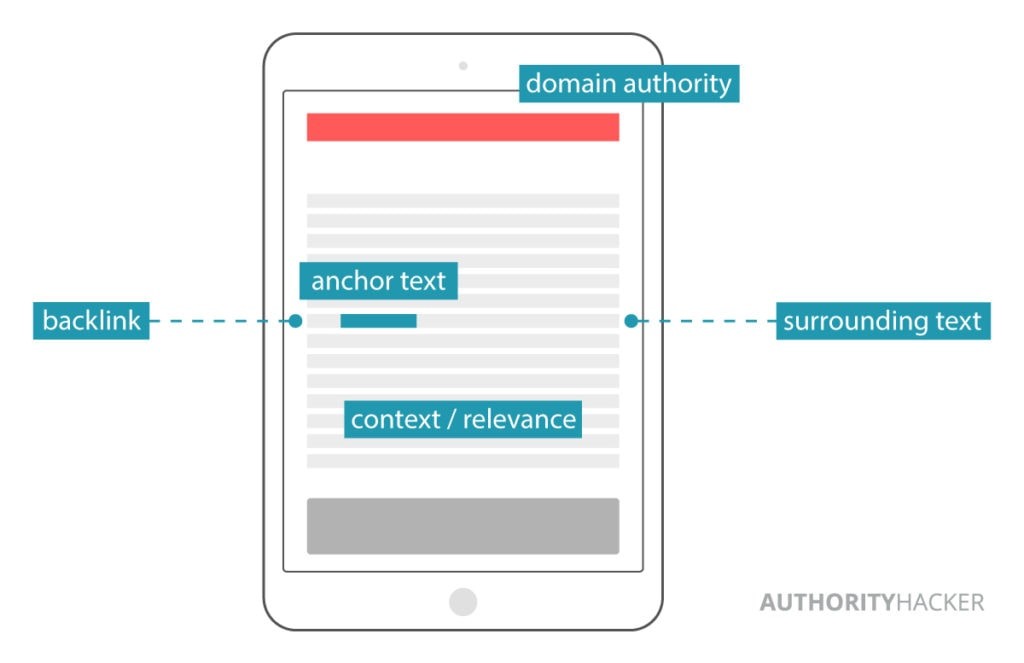
It’s so important that pretty much all seven Penguin updates were largely centered around anchor texts. For those who don’t know, these were the updates that made many websites lose tons of traffic.
And now Penguin is a part of Google’s regular algorithm, which means your anchor texts are looked at in real-time and matter for your rankings.
And that’s what this article is all about.
We looked at best practices and we did our own study, analyzing 1.3 million anchor texts.
All to provide a complete guide to optimizing your anchor texts in 2019.
Read on!
What is Anchor Text
In short, anchor text is the clickable part of the text that links to another URL.
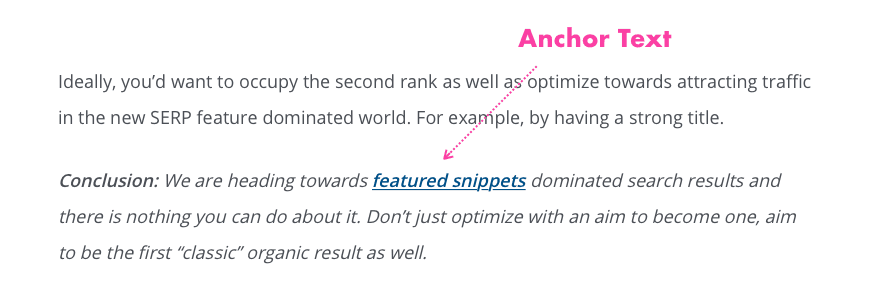
It’s a term that probably comes from HTML terminology.
In plain HTML format, it looks like this:

Other than telling the reader what the link is about, it also represents a data point in Google’s (proverbial) eyes.
There are several types of anchors we’ll refer to in this article:
- Exact match: The text exactly matches the keyword you want to rank for. E.g. we’re heading towards featured snippets dominated search results.
- Partial match: This partially matches the keyword, e.g. get featured in a snippet with this little trick.
- Branded: This anchor includes your brand, e.g. read more about it on Authority Hacker’s website
- No match: This anchor includes neither the keyword nor the brand, e.g. a nice piece of content to learn more about it.
- Image link: To quote Google themselves: “Alt text in images is useful as anchor text if you decide to use an image as a link.”
- Naked URL: E.g. here’s a link to that article: authorityhacker.com/million-serps-analyzed/.
- No anchor: Links without anchors.
I could easily come up with a bunch of other categories to make this article look cool, but in general, these are the categories that matter the most.
You’ll come across the rest in the SEO-sphere and they are just a combination of the above.
Basically, that’s all the technicalities you need to know about anchors. Now, let’s provide a little context to it.
Anchors and SEO, What’s the Theory
In the early days, Google used a fairly efficient, but relatively simple, algorithm to rank pages. It relied mainly on backlinks and keywords.
While keywords used to determine the relevance of a ranking (or linking) page, the total number of backlinks used to be the main signal assigning authority to a page or a domain.
The more links and keywords you got, the better you ranked.
The anchors, by the way, used to be a big part of the keyword game.
There were only 40 million websites in 2002, and 200 million at the time of the first Penguin update, so it worked well.
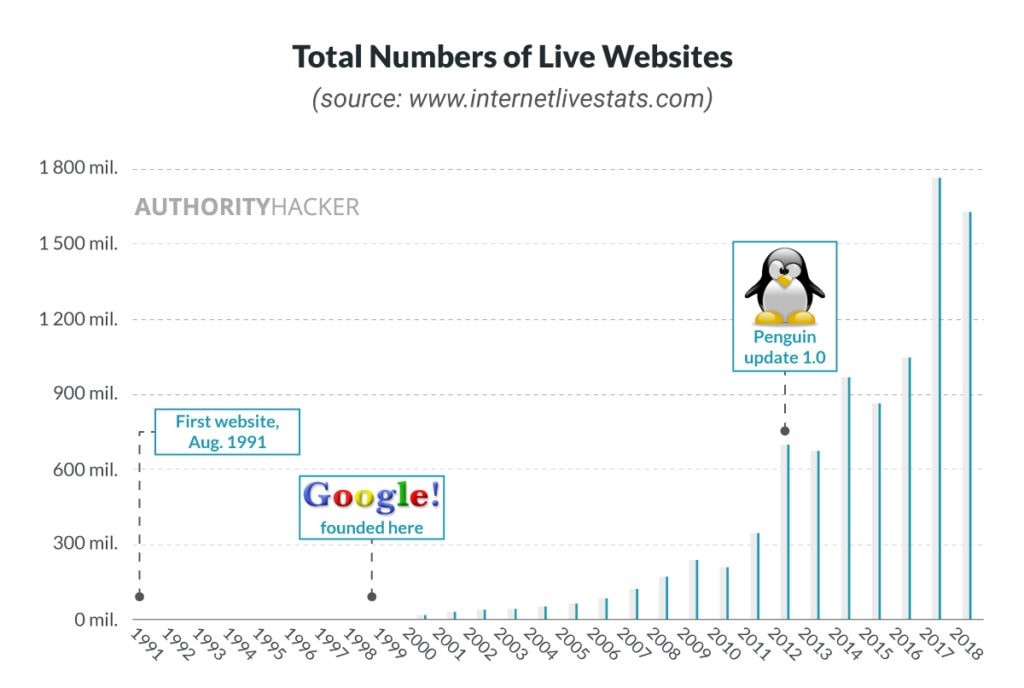
Naturally, this simple system got abused by spammers.
If you managed to get yourself a lot of backlinks from whatever source (there were directories specifically created to sell links) you could have been doing well.
If you stuffed your website with nonsensical strings of keywords (aka keyword stuffing), you could have been doing well, too.
If you spammed the web with tons of links, each with the same anchor, exactly matching your campaign’s keyword, you could have hit the top rank or pulled a practical joke, like this one:

Obviously, Google evolved, technology advanced, and a series of algorithm updates put an end to what used to be the SEO heydays.
Some websites got hit pretty hard.

Google started to spot spammy patterns and the first Penguin update was the start of it all.
If your page had, let’s say, 100 backlinks and 75 of them used “payday loans” as an anchor, you would get penalized.
So, two things have happened since.
- Google became so good at spotting spam that it reached levels close to perfection, given the limits of technology today.
- It evolved from relying on a few simple signals to relying on hundreds of complex signals, all carrying a different weight.
Why don’t we publish these [200 ranking factors]. And the fundamental answer is we’re always changing.
So, What About Anchors
A bit of both, I would say. They’ve become one of the most reliable signals for Google to uncover unnatural backlinks, or, in other words, search spam.
At the same time, it’s still a relevant signal, among many others, providing Google with more context to the quality of the backlinks and the extent of the relevance.
And, as our recent study has shown, relevance matters a lot these days.
Today, however, the general consensus among SEOs is that you should avoid “optimizing” anchor texts. Don’t risk a penalty. Instead, focus on earning links naturally (or seemingly naturally).
In practice, that means you want to have many referring domains with many backlinks, and diversity in anchors.
At the same time, Google makes it very clear that anchors do carry an SEO weight.
It says:
“This text tells users and Google something about the page you’re linking to. With appropriate anchor text, users and search engines can easily understand what the linked pages contain.”
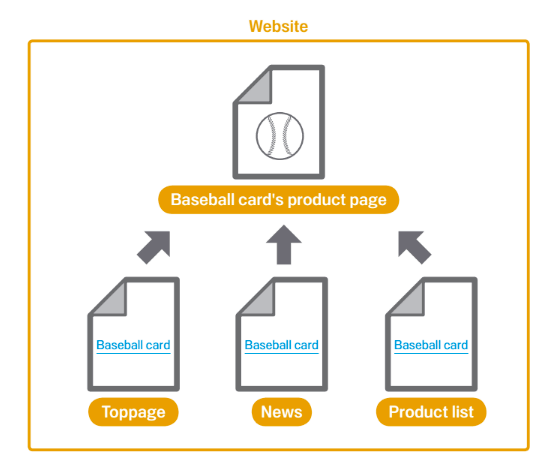
It’s also a well-known fact that Google still uses its original algorithm, but rather as a part of the much more robust algorithm it evolved into.
As of today, Penguin is a part of this algorithm too, which means your backlink profile and its anchors may get flagged in real-time.
So, that leaves us in a rather difficult situation where we hang between risking and avoiding a penalty, or potentially losing some valuable search traffic.
Ok, so What Should I Do
Google provides some general guidelines on the do’s and don’ts of anchor text optimization.
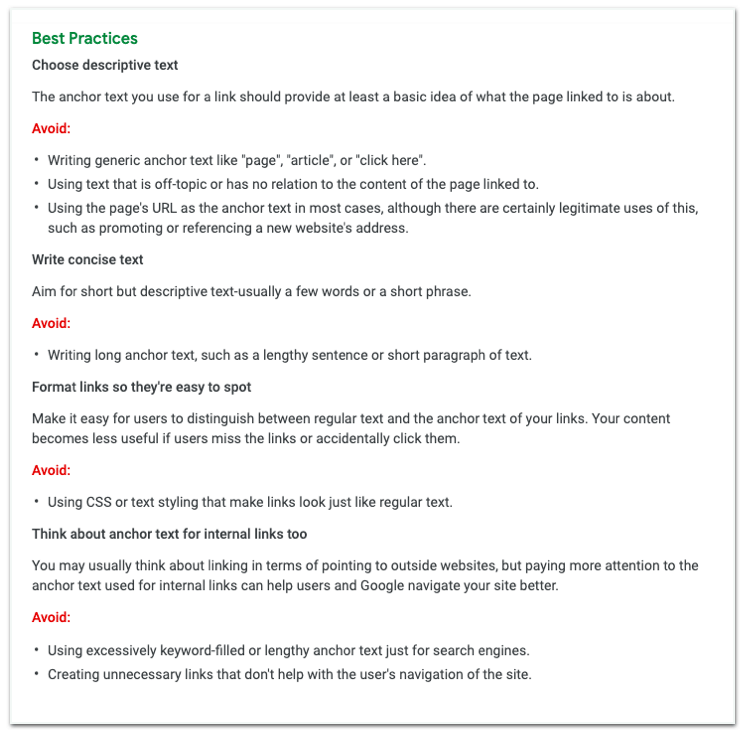
In short, it says you should use descriptive text, not too long, not too short, and avoid over-optimization with keywords.
Helpful, but not that much if you’re someone who likes to get specific.
Well, here’s the thing. All SEO is quantifiable.
That’s because Google is a computer algorithm that relies on data only. As such, it can only work on signals that can be quantified.
Meaning metrics, such as backlinks, keywords, traffic and their numbers, ratios, distributions, and so on.
It’s just that today, as opposed to 2005, Google can process millions of data points from more than a billion active websites, assign scores and red flags, and narrow it down to some 100+ signals that, together, determine your search rank (at a given time, location, and search query).
And anchors, their count, length, composition, distribution, etc. all make up one of those signals.
So, before we get into drawing conclusions on our own, let’s have a look at the data profile of the top-ranked pages and see if we can find quantifiable patterns there too.
Our Study: The Influence of Anchor Text on Search Rankings
We took a dataset of 50,000 URLs, ranking in the top ten for different keywords. Later on, we expanded the dataset to 100,000 URLs with top 20 results to confirm some findings.
We used a randomly created list of long-tail keywords (average 4.85 words, 23.5 characters) with a volume of somewhere between 5000 and 12,000 searches a month.
This isn’t an entirely random dataset as we took extra care to only look at top ten results, where all results are content pages–not root domains, branded results, or other, potentially outlier stuff, like Amazon, YouTube, Twitter, Wikipedia, etc.
To learn more about the reasoning behind it, you can look at our research doc.
Here’s a screenshot of our database:

We then obtained metrics for each of the SERPs, including traffic, backlinks, and anchor texts. Here’s a look at how backlinks correlate, for example.
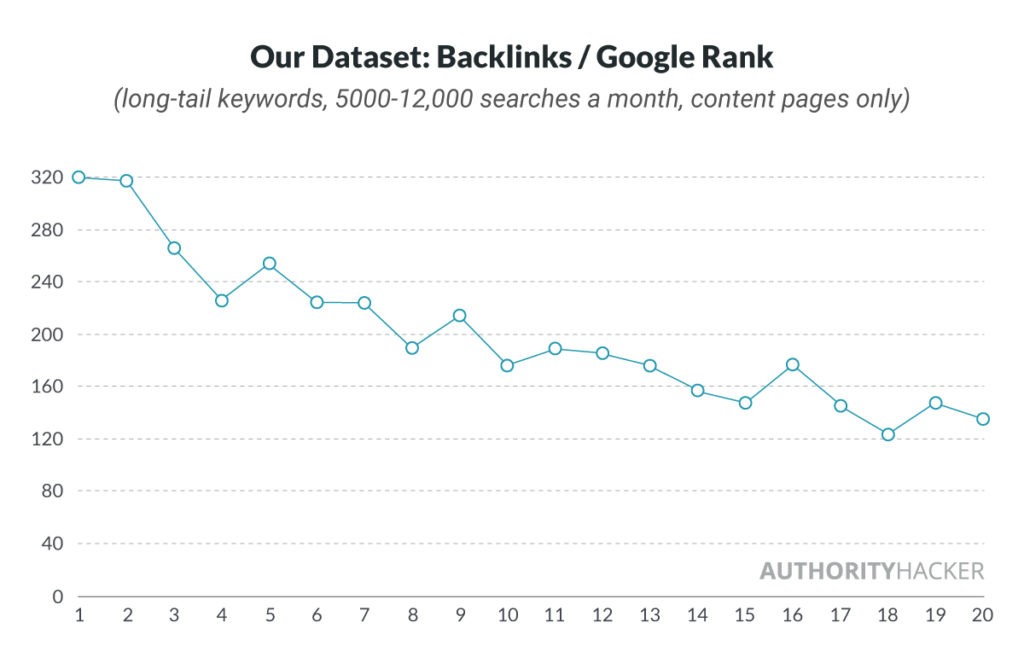
Usually, we see a much higher difference. But it seems that, in terms of content pages, things are a little bit more competitive.
Or rather, the fact that the high volume keywords (5000+ in this case) result in more competition by default. Either way, nice correlation as usual.
I’ll also take this opportunity to let you know that the data we’re about to talk about only includes external links to the site, and that data was provided by the Ahrefs API, just so we’re clear.
1 Anchor Text Variety, Does It Matter
The reason I showed the chart for backlinks is because the first thing we looked at was the number of unique anchors.
I wanted to show you the numbers to provide a bit of context.
So, in our previous study on internal links, some data already hinted that the diversity of unique anchors carries some solid SEO weight.
The data wasn’t conclusive but this time we got it a bit clearer.
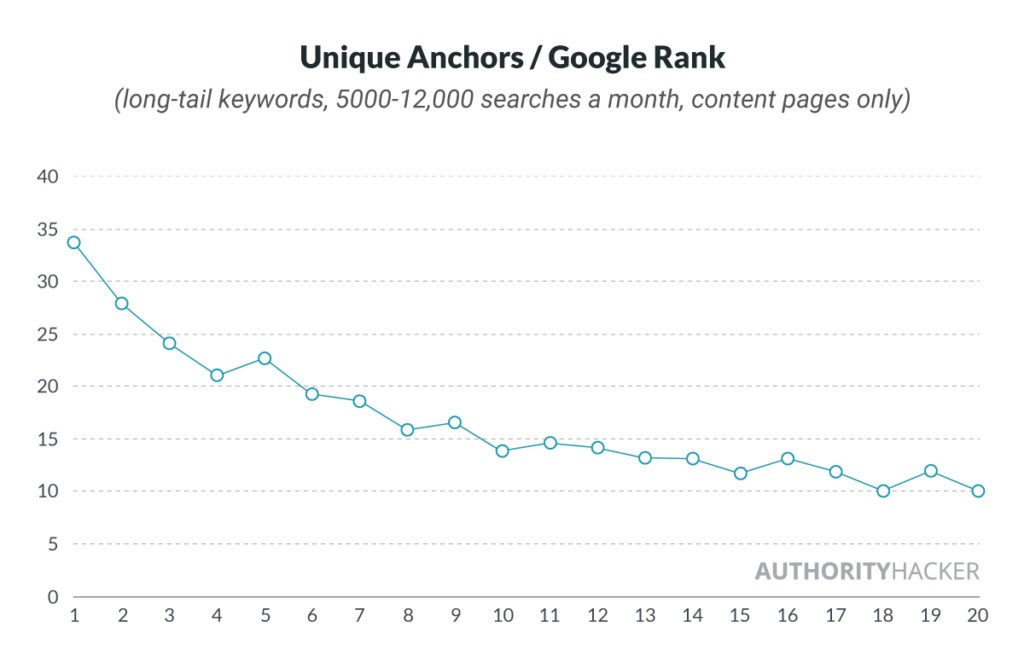
Since the Penguin updates, there seems to be a consensus in the SEO community that you should avoid having too many similar anchors and that you should aim for diversity instead.
This is to avoid having your backlinks profile look spammy.
As you can see, the higher the rank the more unique backlink anchors the page shows. That’s not surprising because when you have more backlinks, you should get more variety in anchors too.
The question is whether the ratio of backlinks to anchor variety increases too. Because, if you score tons of backlinks and only a slightly higher variety in anchors, then the opposite is true.
So, we divided the median of unique anchors per search rank by the median number of backlinks. We did the same with referring pages too.
Here’s the result:
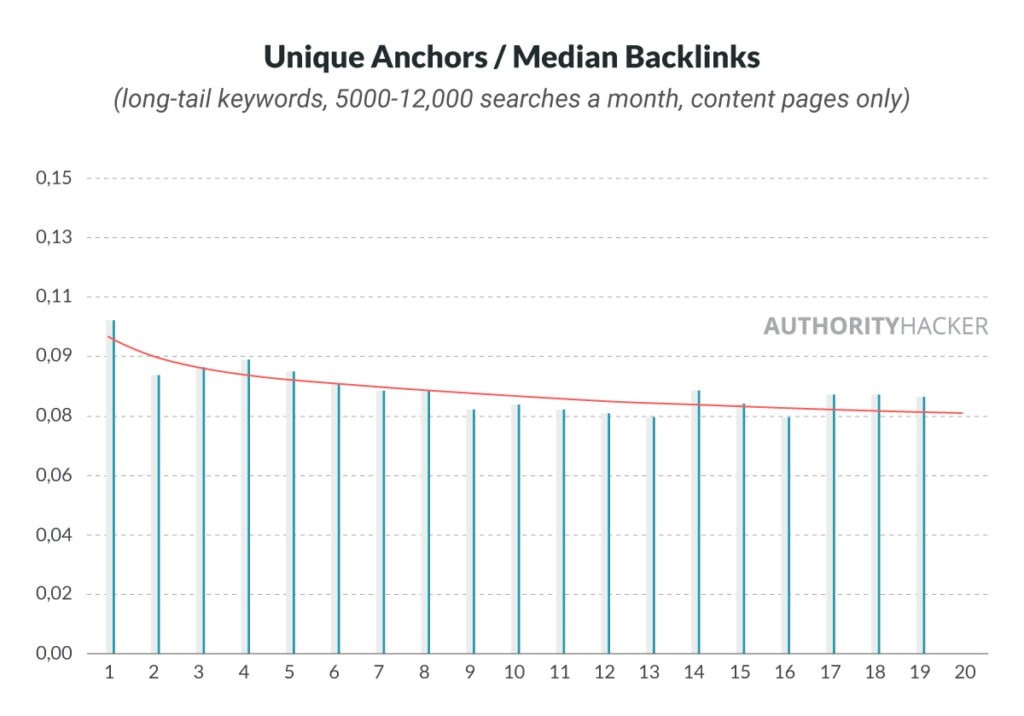
It seems to correlate; i.e. there’s a slightly higher overall variety as the rank increases.
But I don’t think a greater variety is a signal in itself, rather than variety in general. I think, if a web page has one anchor for all backlinks, it wouldn’t even show in the top 20 results.
You see my point? Backlinks are the main factor, and with more backlinks, there are more different anchors. The ratios are more or less proportional to it.
It’s also likely that, with more backlinking pages, the likelihood of someone choosing a completely novel anchor increases disproportionately.
In other words, backlinks rule it all.
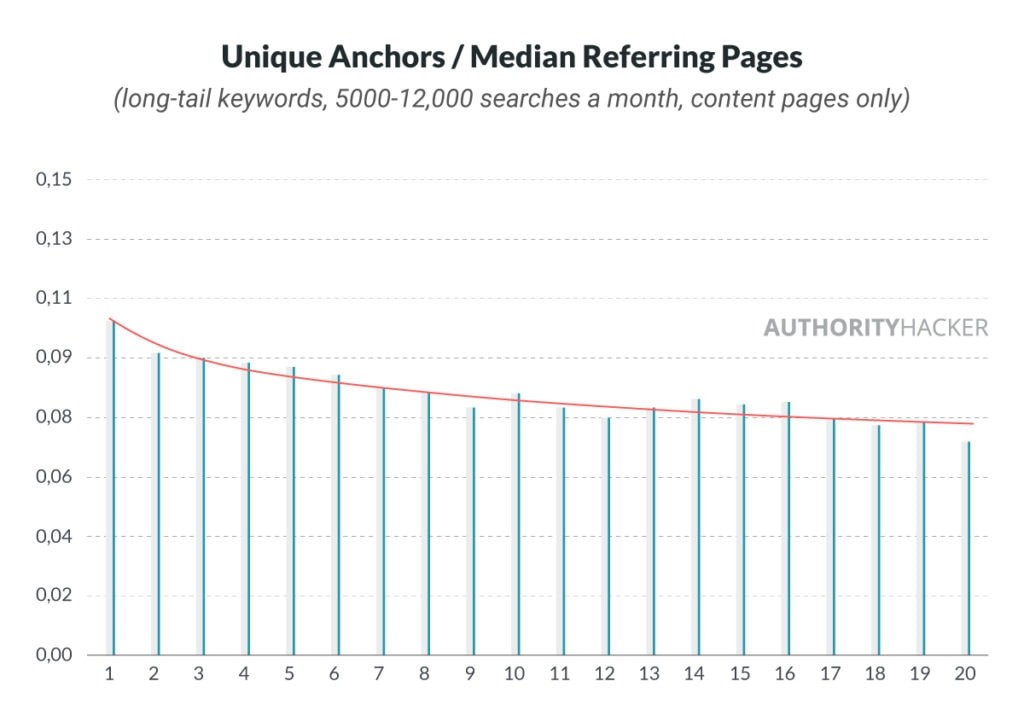
If we’re to speculate…
What’s interesting is that the ratio of anchors/referring pages shows slightly nicer numbers, while the anchors/backlinks are a bit more blurry.
The difference is that one referring page can contain multiple backlinks to the same target.
This might be due to the “first anchor rule”– an idea that, if there are two backlinks pointing towards the same target, Google only considers the first one.
This was confirmed by a few studies many years ago. It’s known to be a part of the original PageRank algorithm and Matt Cutts confirmed it himself in this video in 2014.
Perhaps it is still valid…
Conclusion
It appears that maintaining an anchor variety definitely won’t hurt your rankings. On the contrary, our data suggests it might be a helpful thing to do as all results in the top ten show many different anchors.
As for the first anchor rule, this isn’t a particularly useful piece of information. As Matt Cutts says in his video: “You should really focus on the more important things.”
However, it’s out there and it might be something to bear in mind when trying to optimize your anchor variety. For example, when you’re guest blogging or linking internally.
2 Ok, But What Variety
Let’s do a little recap here. Here are the main types of anchor texts:
- Exact keyword match
- Partial keyword match
- Brand name match
- No keyword match
- Image link
- Naked URL
- No anchor
Often, you’ll find SEO gurus recommending “anchor optimization” formulas, like 70% exact match, 10% branded, 1-2% naked URL, and so on.
Sometimes, advice like that comes from years of real referenced experience. But quite often, formulas like that are simply pulled out of their ass.
So, we had a look at that too.
But first, let’s take it one-by-one.
a. Exact match

Here, we looked at the % of anchor texts that exactly match the keyword that the page ranks for. E.g. the keyword is “random keyword”, so the anchor is “random keyword”
And, we looked at the presence of an exact keyword match within the anchor text. E.g. the keyword is “random keyword”, the anchor is “best random keyword analyzer”.
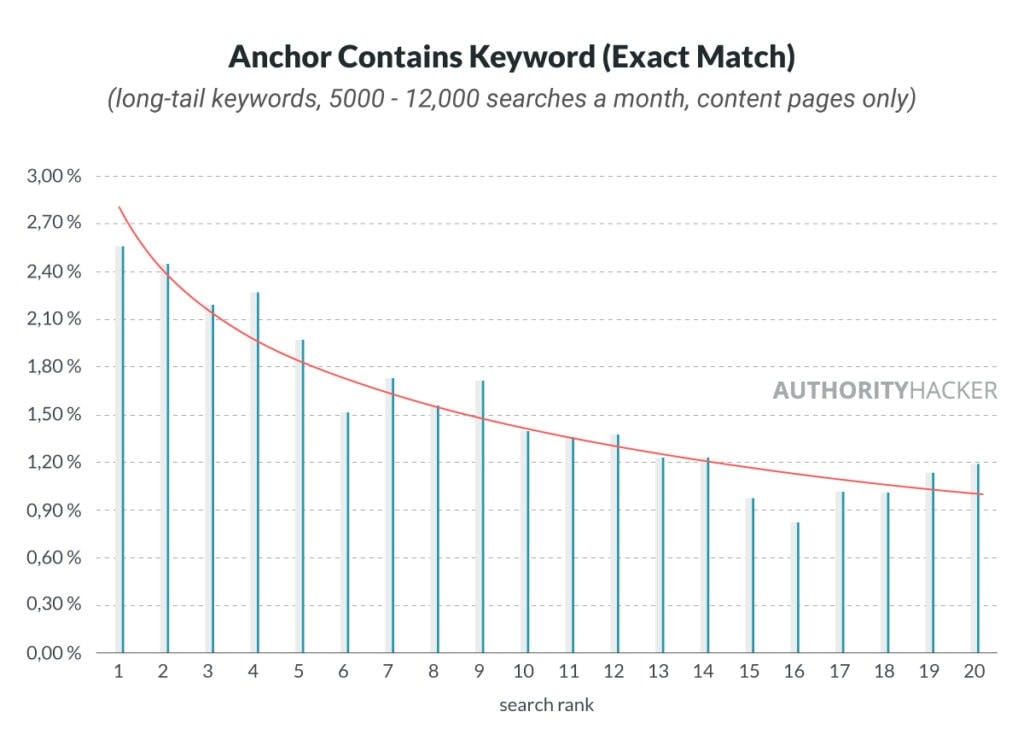
These are averages and they add up nicely. The total number of links with the actual anchor text, as you can see, is quite small, however.
b. Partial match
And here’s a look at partial match. This would be the case where the keyword is “random keyword” and the anchor is, for example, “the keywords were generated randomly”.
We measured the presence of all the main words (we ignored prepositions and stuff like that) in the anchor text. That means that both random and keyword would have to appear in the anchor text.
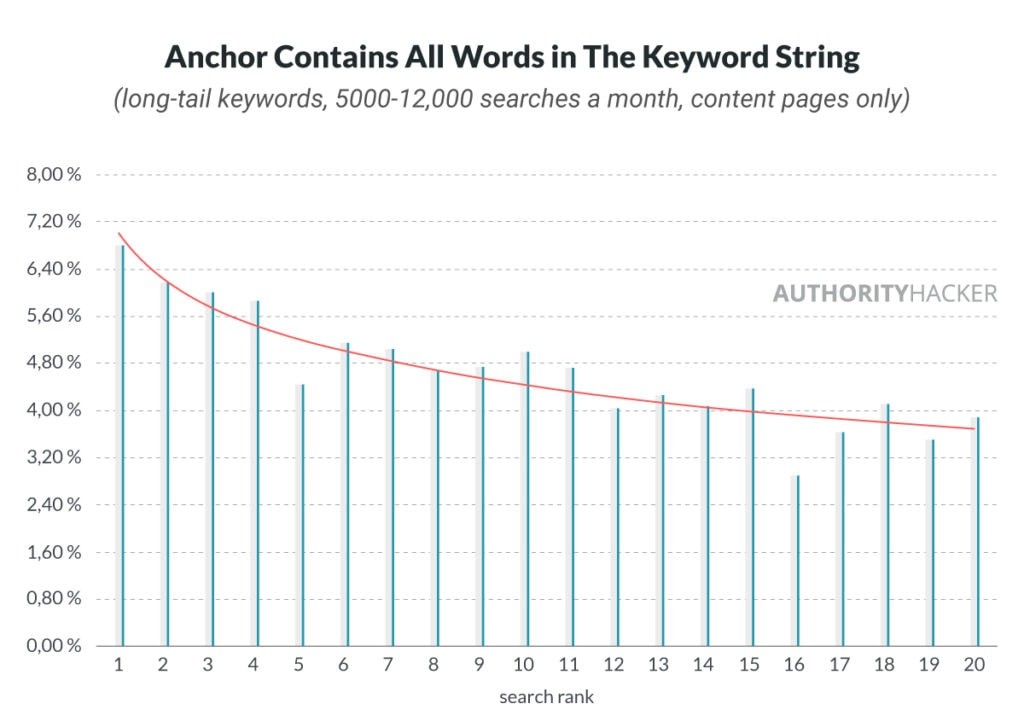
We looked at the presence of at least one of the main words. For example, the keyword is “what are random keywords” and the matching anchor is “how random is it”
We ignored words like “it”, “are”, and so on.
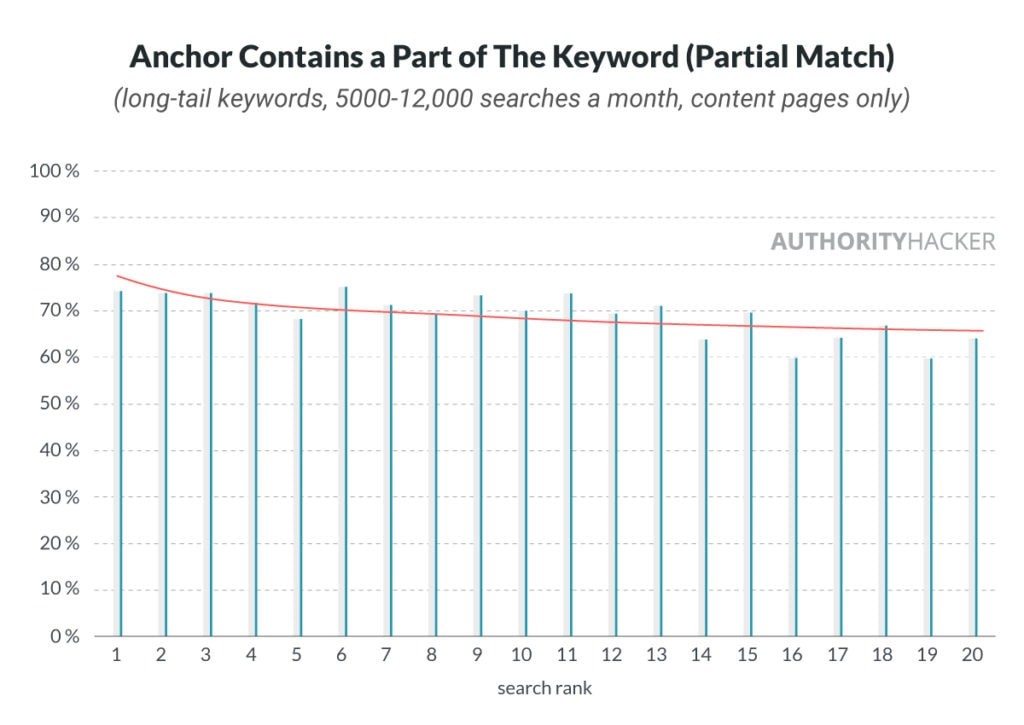
As you can see, no correlation, but quite a lot of the anchor texts somewhat contain some part of the keyword. But, it’s not very clear and the method is a little problematic too.
It’s quite complicated to analyze this. Should we include matches for words like “is”, “how”, “and”, etc.? How does Google evaluate these?
Regardless, the data show some results, and our internal links study returned similar stats on a different dataset. (Check out our 71 Link Building Statistics And Trends in 2025)
c. Brand match
I had to recreate this study a few times to get different results. This one, again, is a little complicated to measure.
We looked at the core of a URL and compared it to an anchor string, stripped of spaces and special characters, to look for similarities.
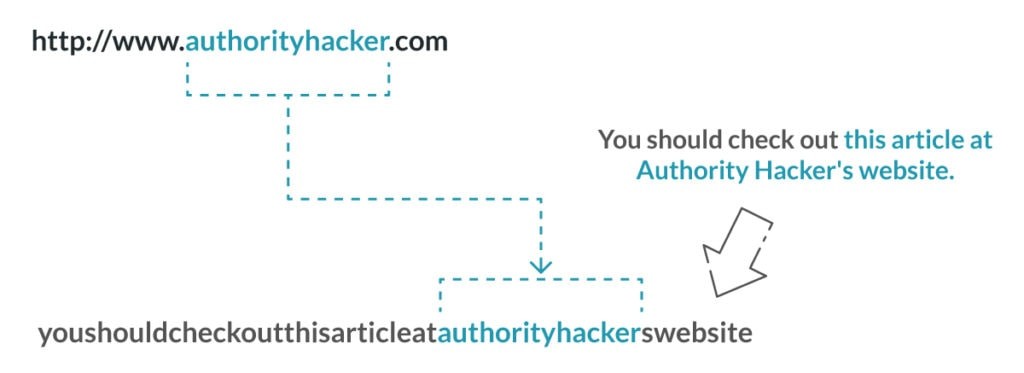
Obviously, you can’t match all brands efficiently, but, in an aggregate result, things should even out and return a higher number where there are a higher number of matches overall.
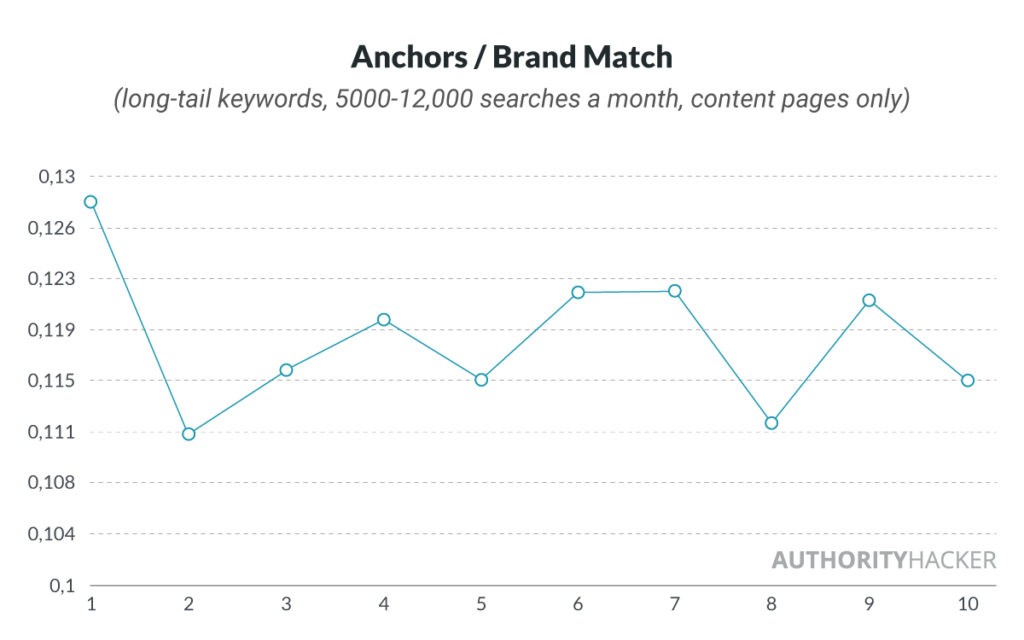
Except, the results, again, aren’t conclusive.
I’ve seen SEOs recommend making the majority of your anchors branded, because: “Google likes to see brands.”
I don’t know what the reasoning behind that is, or how it is that “Google likes to see brands.” Maybe, with branded keywords, it can have a benefit.
But overall, I don’t see how having a link with a, for example, “Authority Hacker” anchor would convey relevance for a topic like “WordPress plugins for SEO”.
d. Naked URL match
This is where it gets interesting.
A lot of SEOs recommend maintaining a number of naked URLs and other not-so-user-friendly anchors, just to maintain a non-spammy appearance.
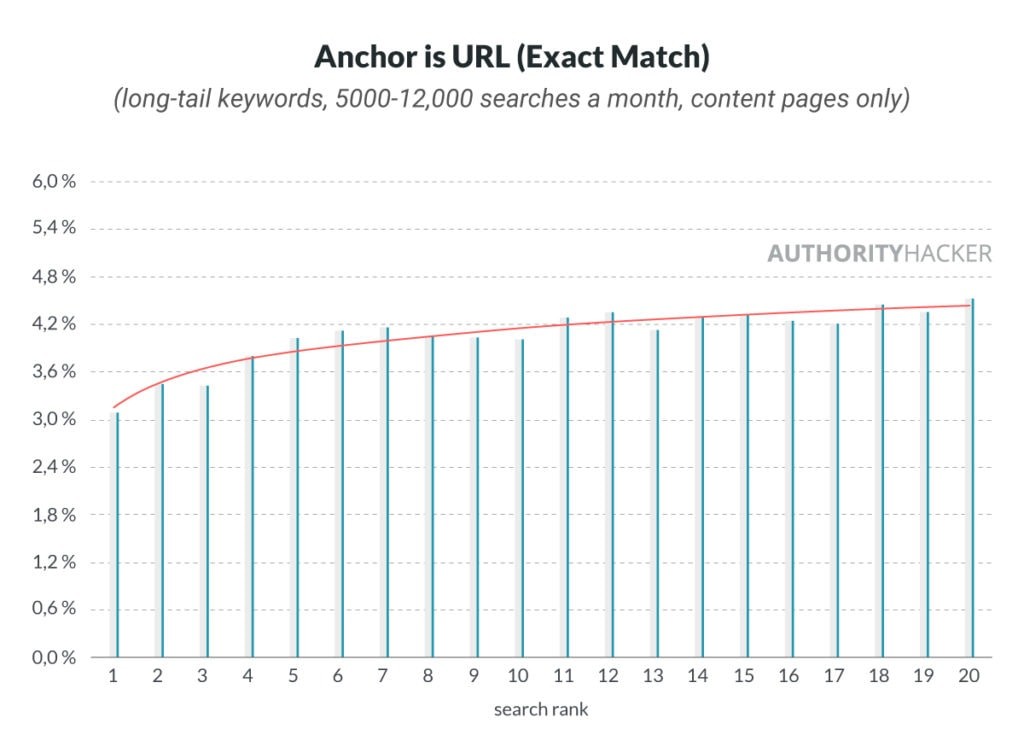
In our study, we found a very solid negative correlation with naked URL anchors. It seems to be the factor for evaluating the quality of the backlinks.
It’s not so clear from the chart, but the rank #20 contains on average 50% more naked URL anchors when compared to rank #1.
It might also be the case that higher-ranked pages just get more links from better websites. Forbes isn’t going to use a naked URL as anchor text, right?
e. No anchor text
There are a lot of empty anchors in our dataset.
I suppose these are links placed around CSS elements, like buttons or things like that. Maybe even images or banners.
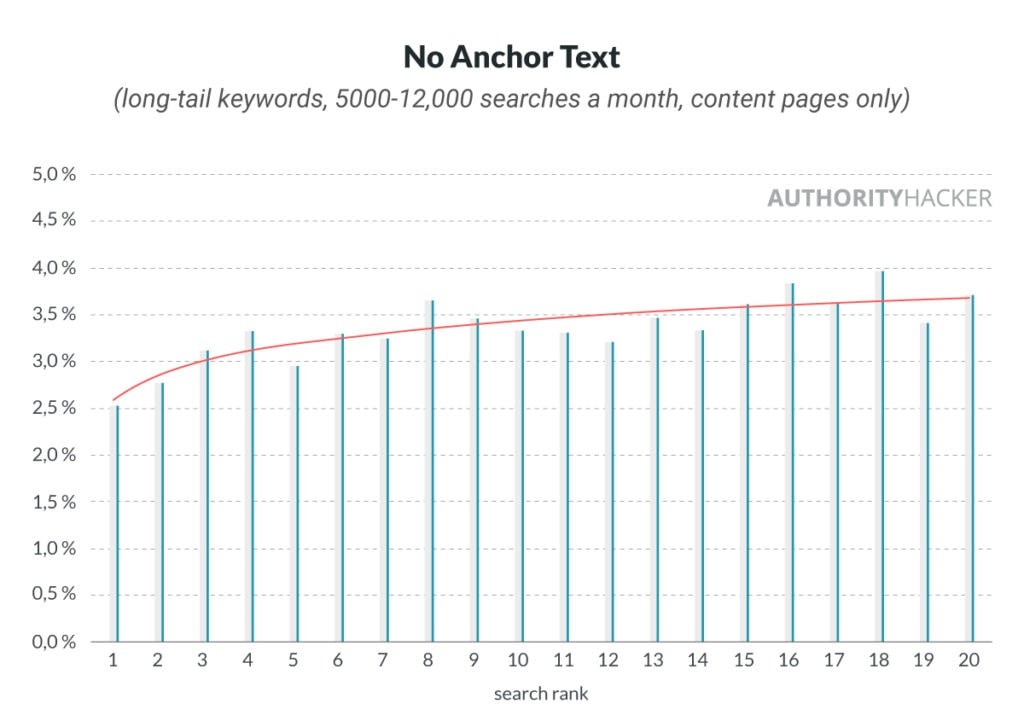
Again, it correlates negatively. And, it’s a nice correlation.
These kinds of backlinks clearly have lesser value in the eyes of Google. And the negative factor here is the missing anchor text.
In last year’s Google Webmasters hangout, John Mueller also made a relevant comment on that topic:
The one thing I would avoid doing is changing anchor text into an image. So, if you have… a fancy font or something that you want to use on your pages and you change a link from being a text link to an image link and you don’t have any textual kind of connection with that image for that link then it’s really hard for us to understand what the anchor text is supposed to be.
So… I think that’s quite clear.
f. Overall Distribution & Conclusion
Google’s recommendation to use descriptive texts seems valid here. Overall, the top-ranked pages have more of the anchors that we can classify as user-friendly.
That means that they provide a context and information to a user, and, therefore, a relevance signal to Google as well.
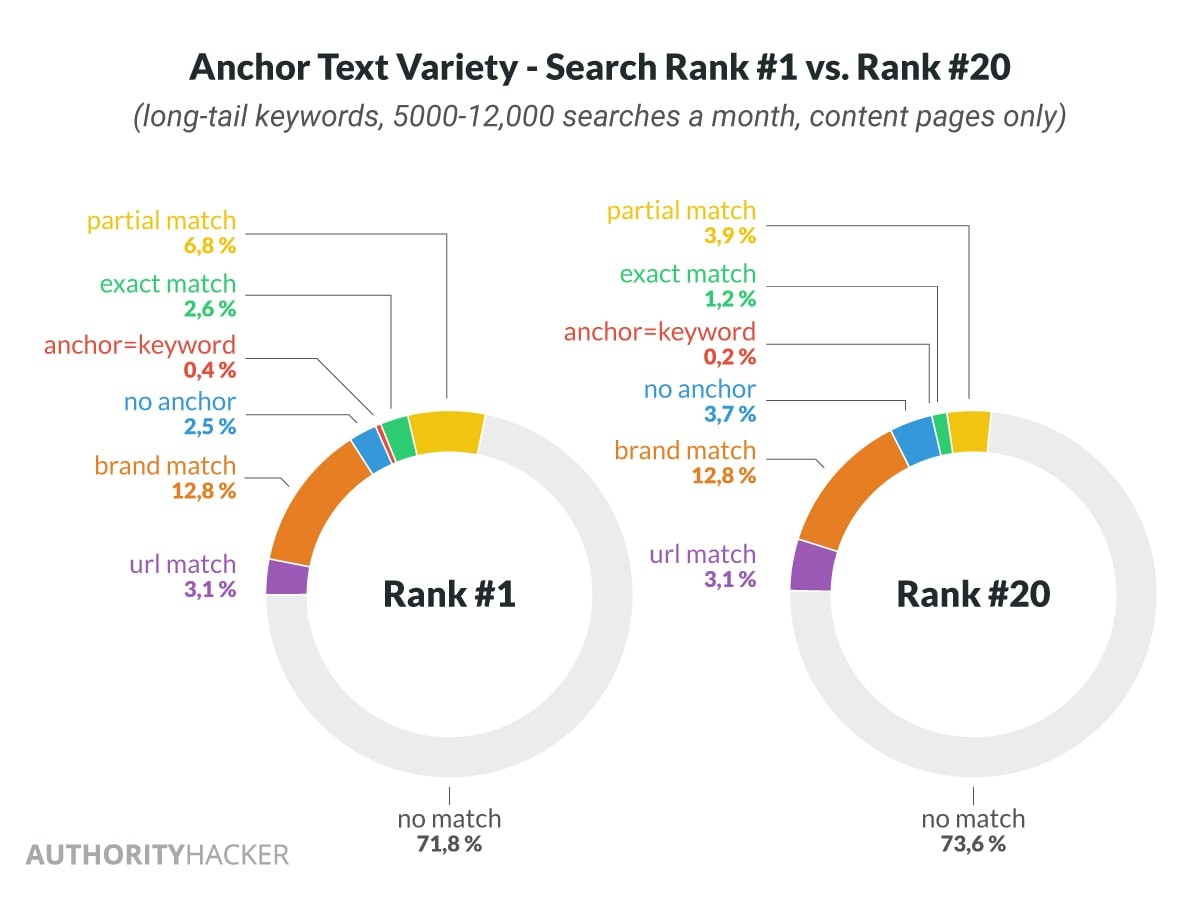
It also seems that having a few solid links with keyword-matching anchors is a powerful thing.
And, while Google warns of over-optimization, it doesn’t explicitly state that optimization is bad. Having some variety and using keyword-related anchors indeed helps.
As for non-matching anchors (i.e. those with no keyword match), every page ranks for multiple keywords so we don’t know if those anchors are completely irrelevant for SEO or simply don’t contain this specific keyword we searched for.
Obviously, if 75% of your anchors match a single keyword that would seem spammy.
But the good news is that the overall number of keyword-matching anchors, while higher for top ranks, is a relatively small number.
So, that leaves space to optimize for multiple keywords while maintaining a variety of anchor texts at the same time.
3 Anatomy of Good Anchor Text
There’s not much to the anatomy of anchor texts, except that Google says: “Not too long, not too short.”
At the same time, the more words it has, the more context it should provide to search engines. Of course, an entire paragraph of anchor text is too much.
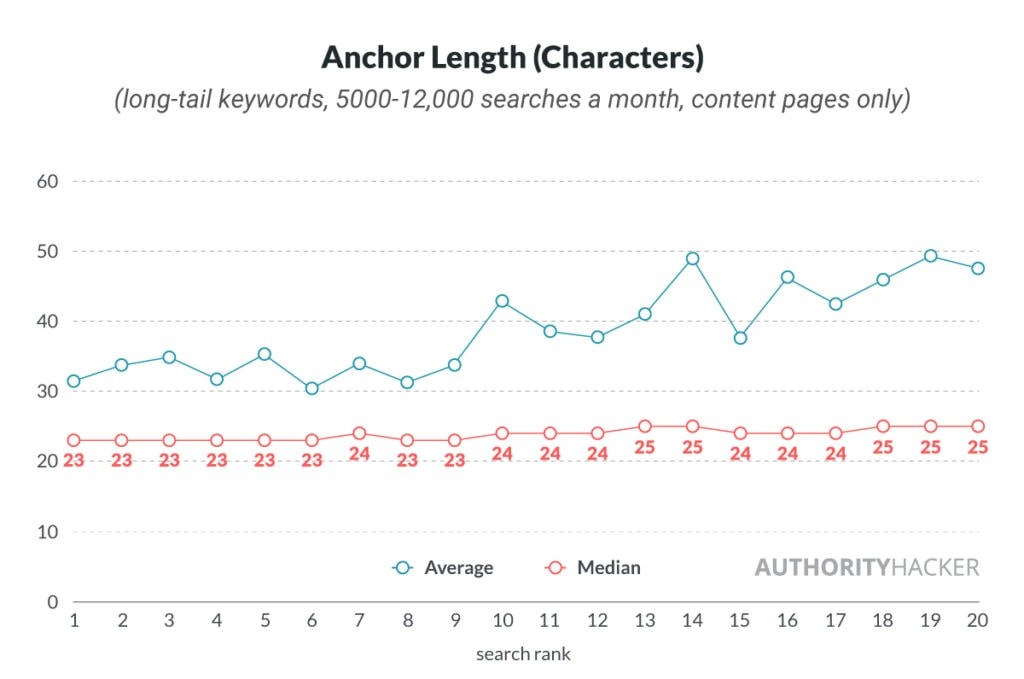
This was surprising, I thought the higher ranks would correlate with longer anchor texts, but the opposite is true.
Here’s a look at the average word count:
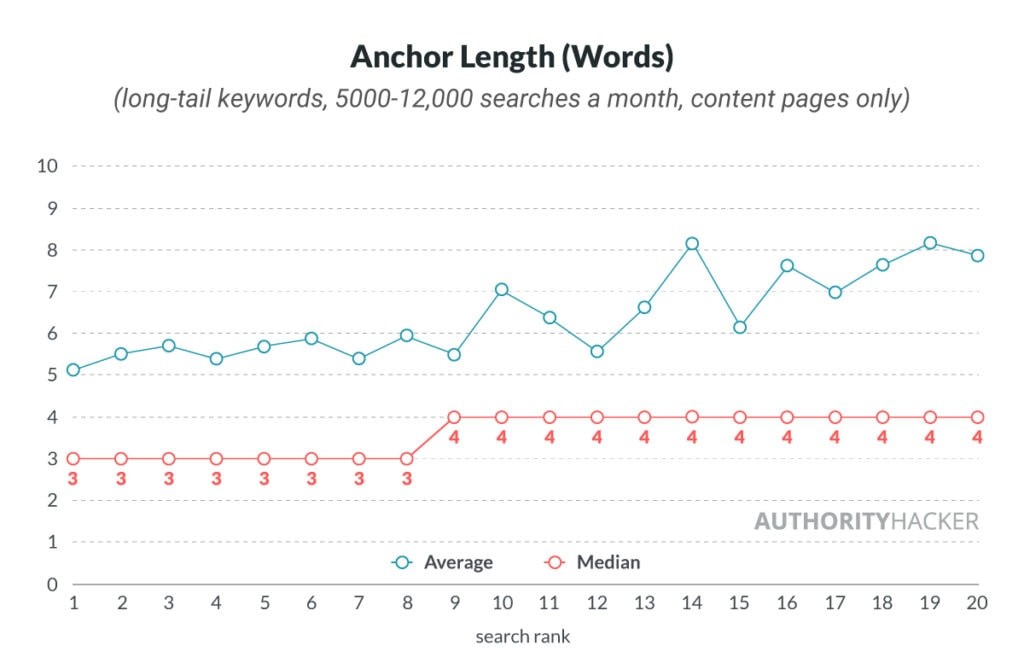
Just to remind you, the average length of keywords in our dataset was 4.85 words and 23.5 characters.
At first, I thought the reason that the higher ranks are shorter is that there are a lot more garbage anchors that are overly long (a few paragraphs or so) among the lower ranks.

Google specifically says you should avoid: “writing long anchor text, such as a lengthy sentence or short paragraph of text.”
That proved to be true when we looked at the prevalence of anchors with a 100 character count.
Here are the results:
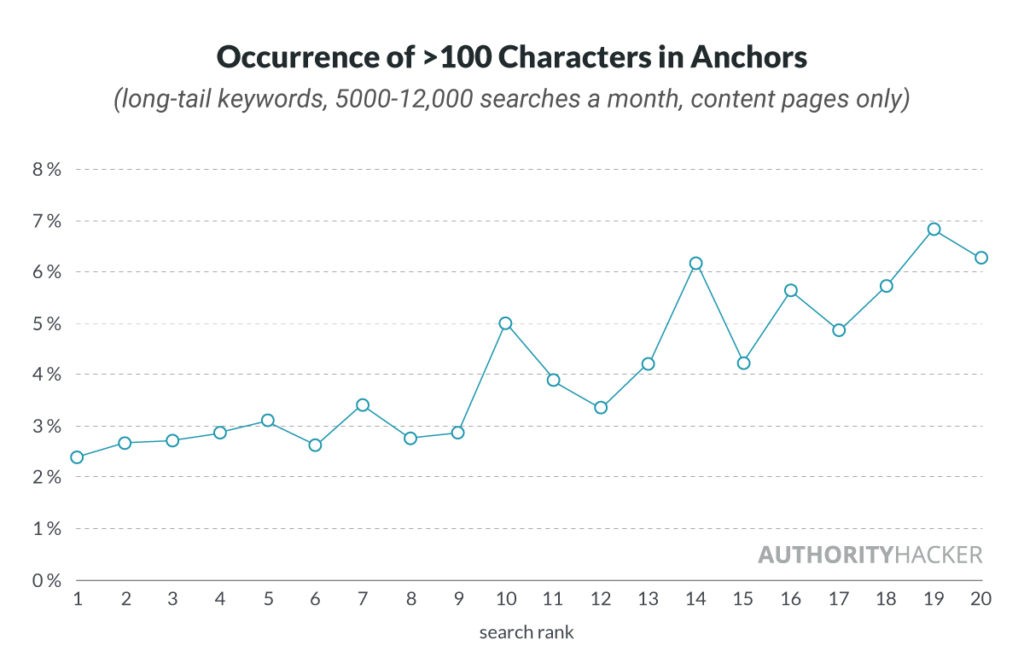
But, Google also advises not to use very long anchor texts, more precisely: “Aim for short but descriptive text-usually a few words or a short phrase.”
So, I thought there might be more substance to higher ranks showing shorter anchors. Next thing we checked was the prevalence of short anchors.
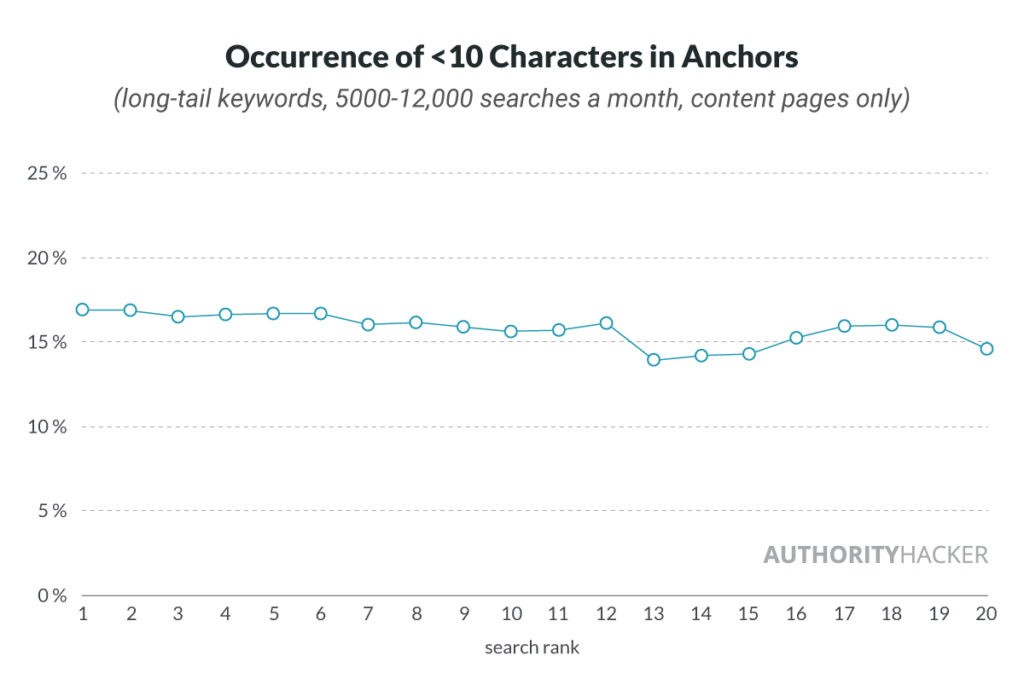
We looked at less than 10, 12, and 15 characters. All seemed to somewhat correlate, although not too clearly.
Conclusion
Do as Google says.
Write short but descriptive anchor texts. A few words are enough.
Also, bear in mind that very long anchors in your backlink profile are quite a liability, just like the “no anchors” and “URL anchors”, as shown in the previous section.
4 Anchors Texts as CTA
One thing I was wondering about is whether the fact that people click on anchors has some influence on the rankings.
What I mean is, if the text invites people to visit the link and sends more traffic, is that increase in traffic a signal itself?
If people click on an anchor, it must mean that it’s effective in providing context. I also noticed that quite a few anchors contain the word “click here”, “read more”, “visit this link”, and so on.
So, I checked the prevalence of these words in the anchor texts and was surprised to find a rather negative correlation.
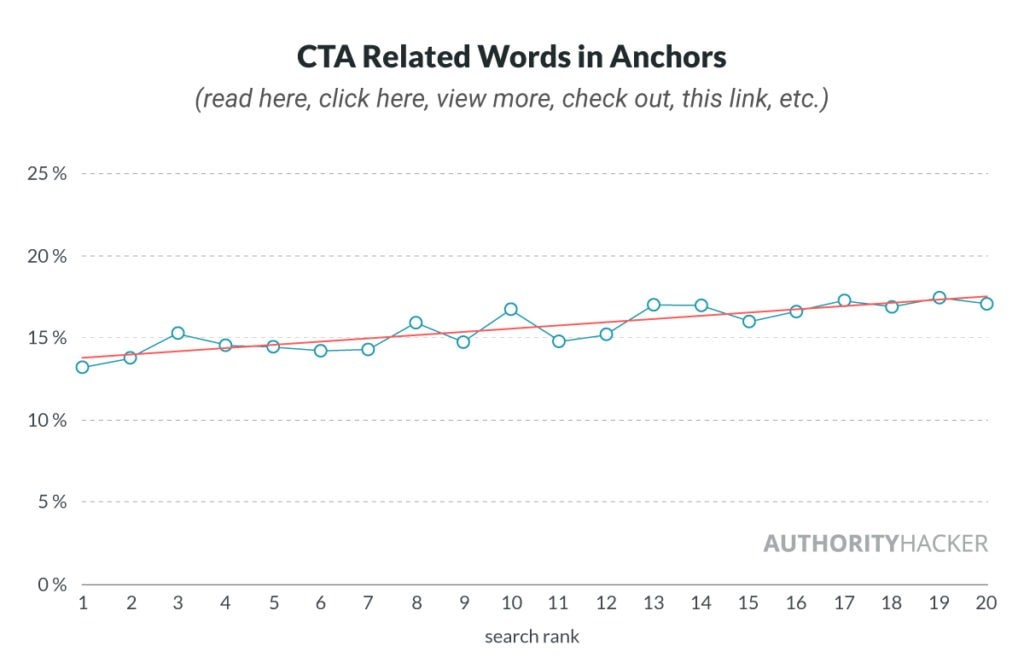
The way I would interpret it, is that spammy sites are more likely selling too hard. So, there may be some relation to that.
On the other hand, when I looked at the word “click here” alone, I found the opposite:
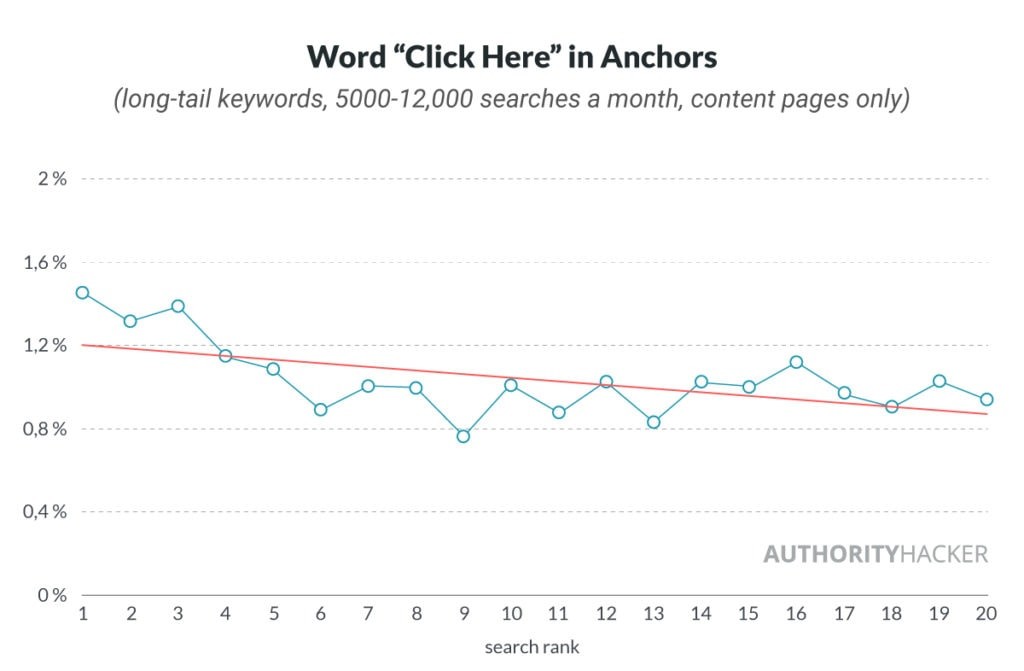
From our headlines study, we know that the choice of “power words” matters a lot. This is still quite confusing, however, but I’ll leave it here just for curiosity.
Conclusion
I think this has little value and the correlations aren’t too strong either. So, I’ll just leave it here for speculation. Maybe someone else will want to do another, more in-depth study on this.
So, What’s The Strategy
Let’s review.
Not everything we looked at validated in a statistically relevant way. But, we can say for sure that some of the recommended anchor text ratios that you see SEO’s talk about are likely nonsense.
I’ve seen people stating that you should have more naked URL anchors, “avoid keywords like the plague”, and maintain variety across anchor types to look non-spammy.
I think you’ll look non-spammy just by having a majority of concise, but information-rich, text anchors and you could even improve by removing the garbage.
And, so far it seems that:
- Naked URL anchors are garbage.
- No anchors are garbage.
- Very long anchors are garbage.
And perhaps, even branded anchors are garbage… No offense.
So, if you have backlinks with anchors like that, it can even help to hit up the site owners and ask them to replace it with something more keyword rich.
About penalties, I think that, if your backlinks are natural, you shouldn’t worry too much about anchors, as long as their variety is proportional to the growing number of backlinks.
So… What Is the Strategy?
Take a look at this pic:
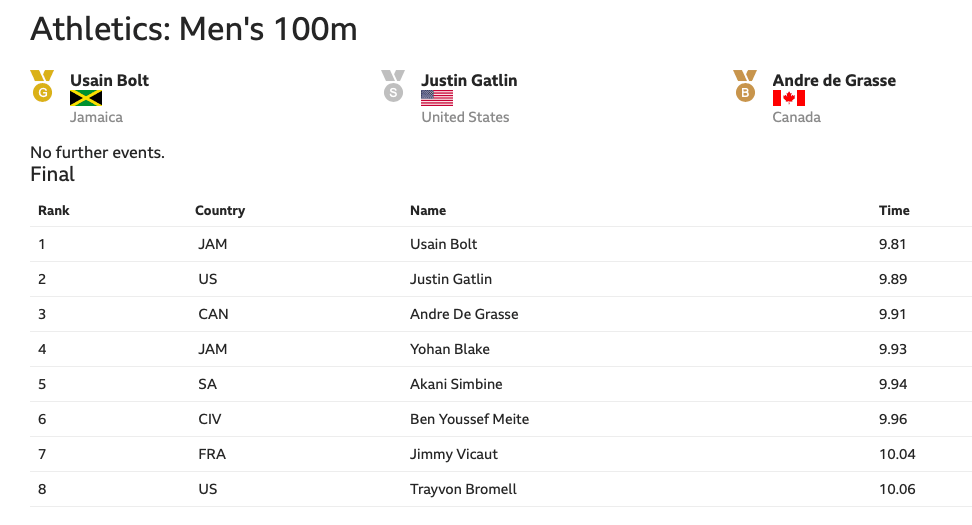
Do you see the difference between Usain and the other guys? And the difference between the second and the third, and so on?
It’s literally centiseconds.
A centisecond is one-hundredth of a second.
Overall, it’s 0.1% wins in the running time that determine the rank in the standings.
Now, do you know how fast an average man can run a 100m sprint? It’s about 15 to 17 seconds.
To even get to the top ten in the table above, an average man needs to make 500x the improvement it takes for the number five to get to number four.
That, by the way, is not a 0.1% win.
But, once you’re in the top ten, centiseconds matter and they matter a lot.
Do you know the net worth of Usain Bolt? It’s $100 million.
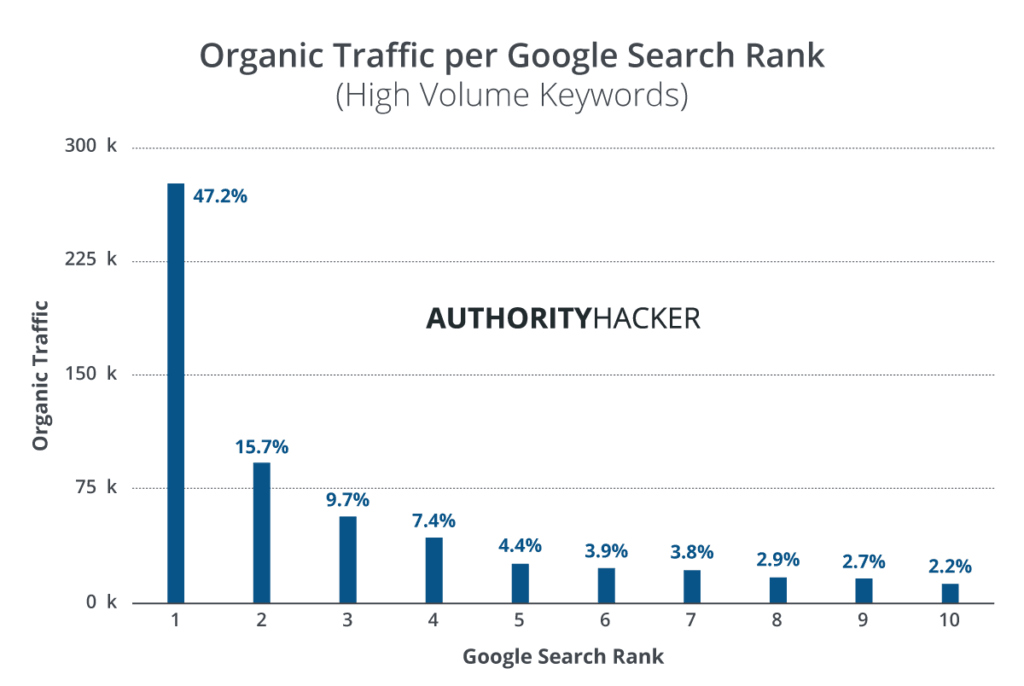
Do you know the net worth of Akani Simbine? Me neither, but I read he just got around a $100k sponsorship that will allow him to continue running without having to find a job.
My point is, 0.1% wins matter, but only if you’re in the top ten.
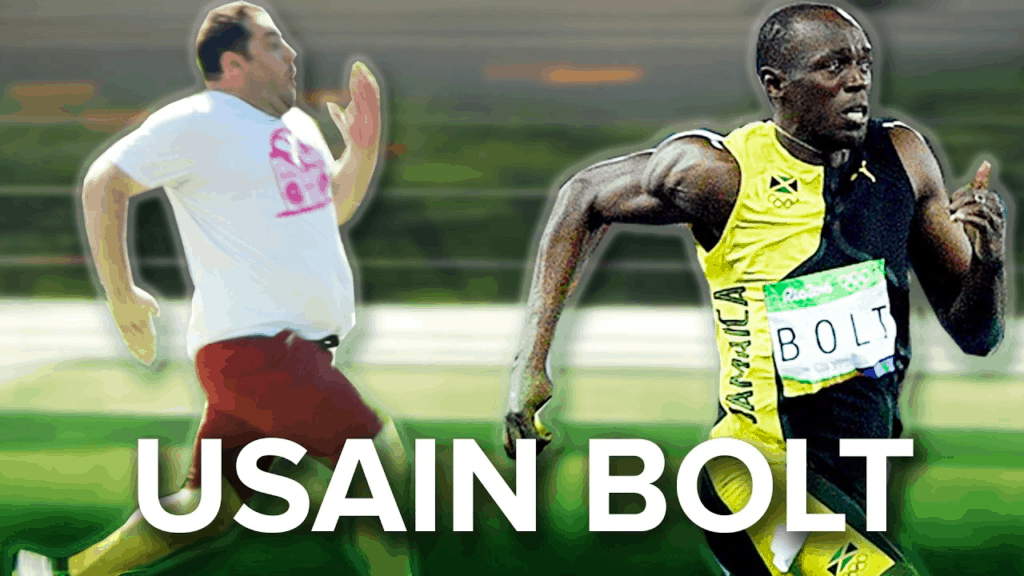
If you’re an average dude, running 100m in 16.99 seconds, instead of 17.01 seconds, won’t make much difference to your bottom line.
You need to make big improvements to even get a chance to compete for the top spot.
And that’s my point.
Anchor text optimization is the centiseconds of the SEO game.
Backlinks and quality content and its promotion are what get you to the “SEO Olympics”, where 0.1% wins, like anchor texts, start to matter.
And that’s your game plan.
Step 1: Build up a Solid Backlink Profile
This takes a lot of work, but it’s the main objective that every site owner should focus on.
You’ll want to produce quality content, build up your audience, and, as a result, you’ll be getting a lot of quality, relevant, and natural backlinks.
Of course, you can push things faster by doing some promotion, building relationships with other bloggers, doing PR, and so on, but it all starts with quality content.
We outline the process we recommend in this post, I suggest you check it out if you need to build a lot of links to your site.
Once you get your pages ranking in the top ten, that’s when you start working on the 0.1% stuff. Like anchor text optimization.
To run a quick analysis, you can use Ahrefs -> Site Explorer -> Top Pages:

We use Ahrefs because it allows us to basically do 100% of our SEO work, so this tutorial will be mainly centered around Ahrefs.
Alternatively, you can use Ubersuggest for free, although it’s quite limited at this point. (And probably will stay limited while it’s free.)
Step 2: Find Your Top Keywords
Once you rank in the top ten, it’s time to take things further.
When you hit the top pages in Ahrefs, you can check your organic keywords for each -> Organic keywords:
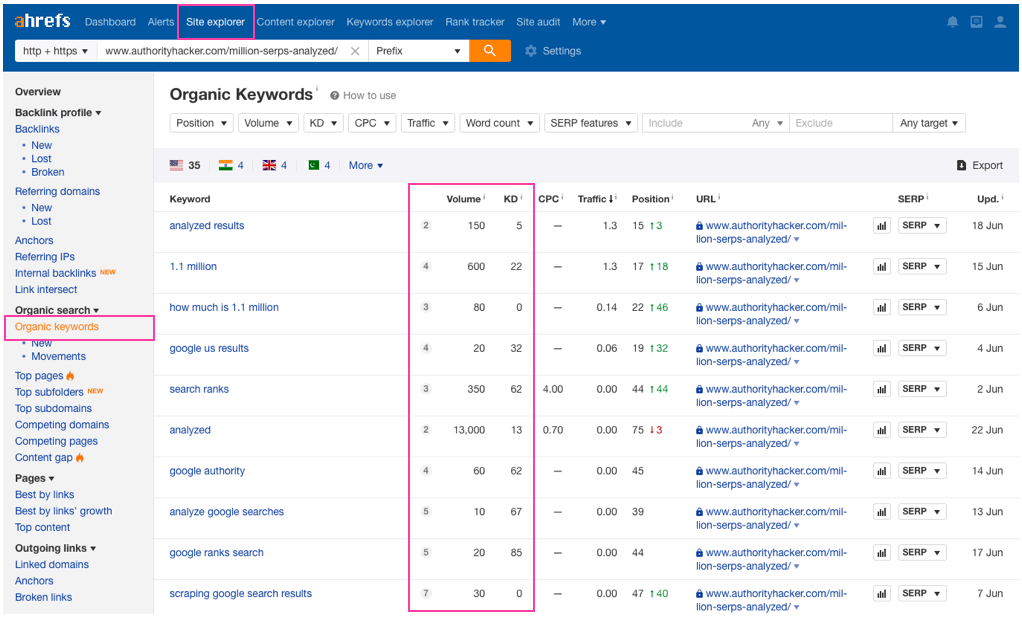
You’ll want to narrow down the keywords with the best potential. Look at keyword difficulty, traffic, and relevance in terms of the topic and the kind of backlinks you’ve been getting.
E.g., in the screenshot above, there’s no point aiming for the keyword “1.1 million” as it has little relevance to the topic and has low, inadequate traffic, even though the difficulty is low.
We outlined all of this in our tutorial and study on internal links, but, in short, look at these three factors and make your best judgment. (Do read that article on internal links though.)

So, you want to narrow down a few of the most lucrative and relevant keywords. And by relevant I mean: “Are they going to bring you the traffic you want to get?”
Step 3: Anchor Text and Backlink Analysis
Go to site explorer -> anchors to see what your anchor distribution looks like.
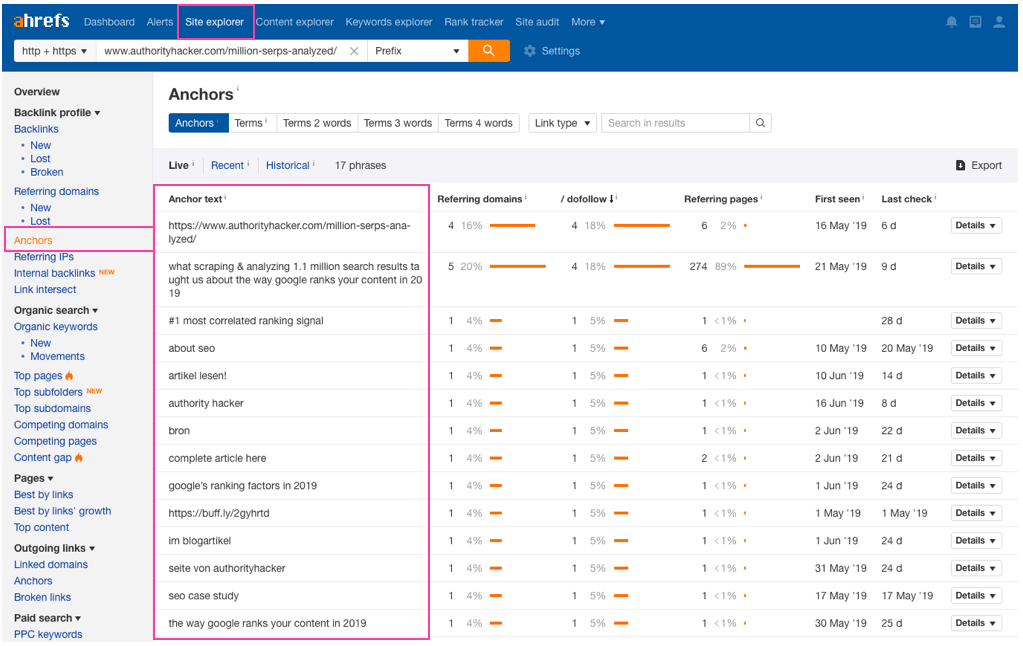
Google recommends useful, concise, and descriptive texts. So, pay attention to anything that doesn’t fall in that category.
To get a better overview, go to -> backlinks, where you can see who links to your page, the location of the link, and what the surrounding text is to get some context.
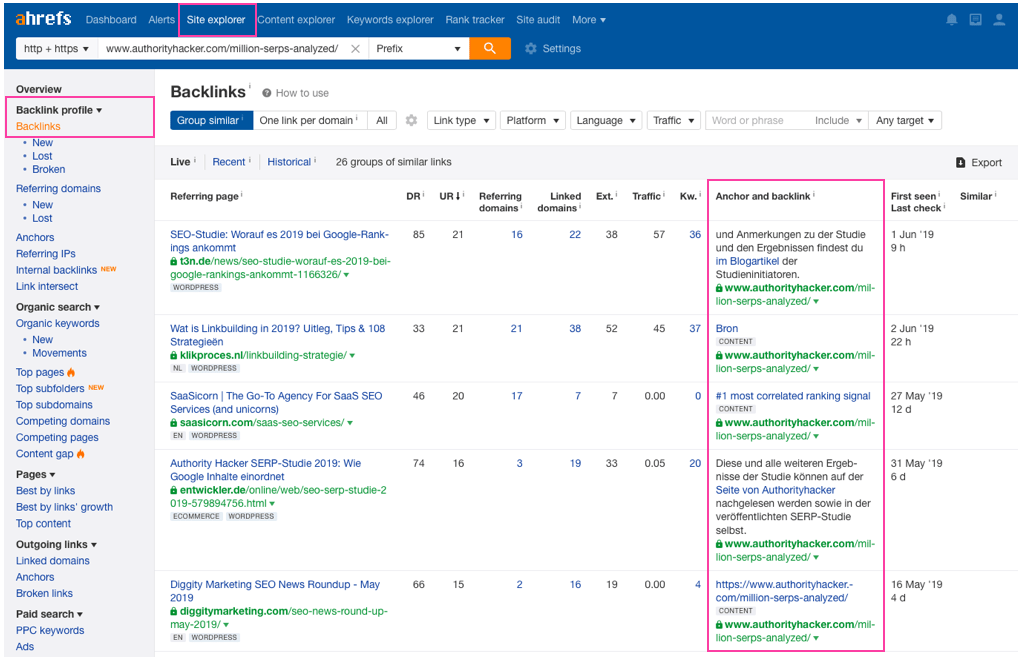
Look at the ratio of unique anchors vs. backlinks. In our study, we found a ratio of about one unique anchor for ten backlinks.
Look at the domain ratings (DR) of the linking pages to get an idea of how valuable each backlink is.
Write all of this down, including some not very useful anchors, the websites, and the pages they appear on.
Next, you’ll want to do some work on this.
Step 4: Anchor Text Optimization
In general, you don’t have much control over the anchor texts on other people’s websites, but there are a few things you can do to balance things out:
- Reach out to website owners.
- Guest blogging.
- Optimize your internal links.
a. Reach out to website owners
Here’s why it pays off to develop relationships with other bloggers. How to do it is a completely different topic.
In the case of no relation to the website, you can always try to reach out. If they linked to your article, they know about you and there’s a solid chance they’ll be receptive.
There’s a bunch of tools that help with cold outreach, such as email finders like Hunter, or a simple lookup on Whois.

But the best thing to do is build relationships on the go and ping the website owner whenever you get a new backlink.
Here’s an example:
Hey [Name]
I was just browsing my analytics today and noticed that you recently linked to my content ([link]) from your site.
I just wanted to say: Thanks a lot! That’s truly appreciated and I’d love to repay you the favor someday. Just let me know how I can help :).
Sincerely,
[Your Name]
About emailing websites en masse to fix broken links and faulty anchors… That’s a tactic that yields good but not great results. You might get three to five positive outcomes out of 100 emails.
But, that does translate to 3% – 5%, and, as you can see in the charts, incremental improvements make a lot of difference.
b. Guest blogging
Guest blogging gives you some control over the backlinks you get from it. It’s a great tactic, but it has its downsides too.
- First, you’ll want to avoid spammy websites and go for legitimate blogs, otherwise, it may even hurt your SEO.
- Second, don’t expect many other benefits from it, other than backlinks.
So, if you’re going to do it for the backlinks alone, make sure to reach out to many websites so you have some diversity in your back-linking guest posts.
That means, don’t get stuck writing for one website only, as it’s believed that subsequent links from the same domain have diminishing SEO value.
You will find a lot of opportunities, simply by typing into Google:
[your topic] “become an author”
[your topic] “write for us”
and so on…
There’s a lot more to guest blogging but that’s an entirely different topic.
c. Fixing your internal links
A lot of anchor-optimizing work starts on your own website. The good news is that, unlike external backlinks, you have full control here.
It’s also a great place to start if you want to balance out your anchor text variety. Again, we wrote an entire data-backed guide on how to do this.
Conclusion
Going back to my running analogy, there’s a popular saying in sprint coaching that says: “A sprint coach can’t make you fast, he can only make you faster.”
In other words, to compete at a level where minor tweaks make a huge difference, you have to have a solid ground base.
That solid ground base is epic content and lots of high-quality backlinks.
Once you reach that point, you can play around with anchor texts and see what works and what doesn’t. Until then, building that ground base should be 100% your focus.
Just like running a centisecond faster doesn’t make much difference to an average dude, optimizing anchors on a few backlinks won’t make much difference for you either.


